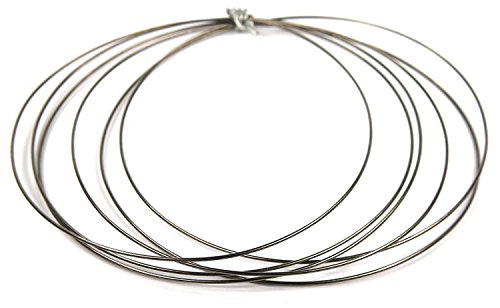Each package contains one 5-foot-long coil (60 inches minimum material length) of pure Niobium wire in 20 gauge AWG (.031 inch diameter or .8 mm). The wire is in a loose, manually-coiled shape. Care should be taken when opening the coil for the first time, as the wire has a light spring to it.
It's fun and easy to make your own pierced ear-wires. Cut a 4-inch piece of wire. Fold it in half. Bend it around a mandrel such as a pen or pencil. Use round-nose pliers to create a small loop at one end. Use wire cutters to trim the ends so that they are the same length, then cut off the folded edge. Use a metal nail file to smooth the cut edges. Within seconds you have 2 identical ear wires, made out of the most exotic, rare, gorgeous, and biologically safe metal in the world. NIOBIUM, the best friend of sensitive skin.
- Niobium metal is physiologically inert, making it 100% safe for use in the human body. (It is even used in medical devices such as pacemakers.) Niobium by its very nature is PURE, meaning it is not an alloy, or mixture, of other metals. Niobium is beyond hypoallergenic, it is NON-allergenic. It does not react to body temperatures or moisture. You can swim and shower, and even sleep with Niobium metal in your piercings.
- Shiny, smooth finish. Niobium is even more gentle in piercings than titanium because of its smooth finish. (Titanium has a slightly abrasive finish). Niobium surpasses all other metals in terms of bio-compatibility. Even people who have reactions to Gold can wear Niobium in their piercings.
- 20 gauge. This is the most popular thickness for earwire construction, fits comfortably in most ear piercings. 20 gauge is also appropriate for creating matching jewelry findings. Make your own custom pierced-ear-wires, with matching jump rings, eye pins, and more.
- Unannealed temper. Unannealed is an excellent temper (hardness) for both manual and machine construction of jewelry findings: its medium-hardness is flexible enough to form by hand, yet stiff enough to hold its shape after forming. Unannealed is comparible to, and perhaps slightly stiffer than, half-hard temper. Anything you can do with precious metal wire, or even craft wire, you can do with Niobium.
- Color: Niobium metal in its natural state is a beautiful lustrous dark silver color. The color within a length of any given 5-foot piece may vary slightly from light to dark or shiny to very shiny. This is a normal variation within the product. The changes are subtle and gradient in nature.
- Niobium metal is physiologically inert, making it 100% safe for use in the human body. (It is even used in medical devices such as pacemakers.) Niobium by its very nature is PURE, meaning it is not an alloy, or mixture, of other metals. Niobium is beyond hypoallergenic, it is NON-allergenic. It does not react to body temperatures or moisture. You can swim and shower, and even sleep with Niobium metal in your piercings.
- Shiny, smooth finish. Niobium is even more gentle in piercings than titanium because of its smooth finish. (Titanium has a slightly abrasive finish). Niobium surpasses all other metals in terms of bio-compatibility. Even people who have reactions to Gold can wear Niobium in their piercings.
- 20 gauge. This is the most popular thickness for earwire construction, fits comfortably in most ear piercings. 20 gauge is also appropriate for creating matching jewelry findings. Make your own custom pierced-ear-wires, with matching jump rings, eye pins, and more.
- Unannealed temper. Unannealed is an excellent temper (hardness) for both manual and machine construction of jewelry findings: its medium-hardness is flexible enough to form by hand, yet stiff enough to hold its shape after forming. Unannealed is comparible to, and perhaps slightly stiffer than, half-hard temper. Anything you can do with precious metal wire, or even craft wire, you can do with Niobium.
- Color: Niobium metal in its natural state is a beautiful lustrous dark silver color. The color within a length of any given 5-foot piece may vary slightly from light to dark or shiny to very shiny. This is a normal variation within the product. The changes are subtle and gradient in nature.









